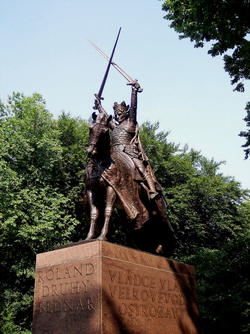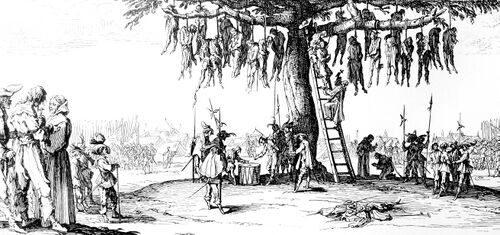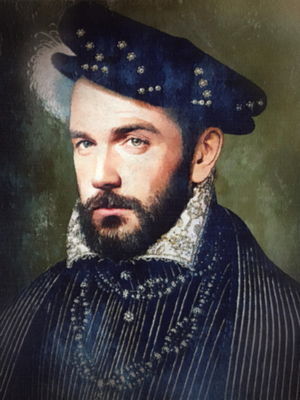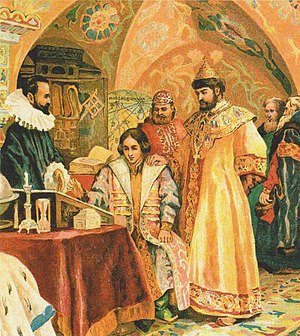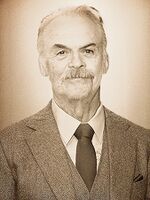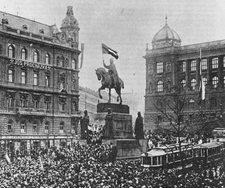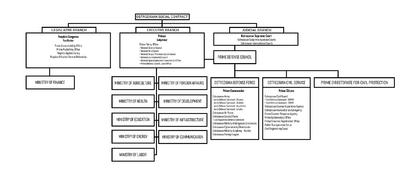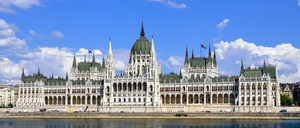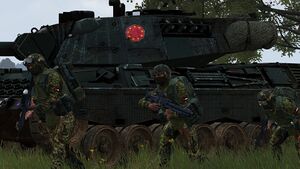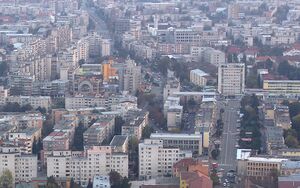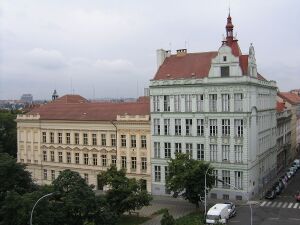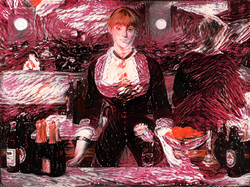Ostrozava: Difference between revisions
No edit summary |
|||
| Line 247: | Line 247: | ||
| width1 = 155 | | width1 = 155 | ||
| alt1 = [[Vincenc Dostál]] | | alt1 = [[Vincenc Dostál]] | ||
| caption1 = [[File: | | caption1 = [[File:OstrozavaFacilitatorEmblem.png|15px]] Facilitator<br /><small>[[Vincenc Dostál]]</small> | ||
| image2 = Moravec.jpg | | image2 = Moravec.jpg | ||
| width2 = 155 | | width2 = 155 | ||
Revision as of 19:40, 7 October 2020
This article is incomplete because it is pending further input from participants, or it is a work-in-progress by one author. Please comment on this article's talk page to share your input, comments and questions. Note: To contribute to this article, you may need to seek help from the author(s) of this page. |
Prime Republic of Ostrozava Primární Republika Ostrozavská | |
|---|---|
Motto: "Dělníci se spojují, aby se dařilo!" "Workers, come together to thrive!" | |
 Ostrozava's Location in Belisaria | |
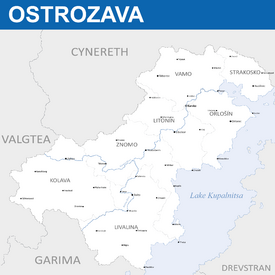 Political Map of Ostrozava | |
| Capital and largest city | Karsko |
| Official languages | Ostro-Ludzic |
| Recognised regional languages | Gariman, Livalian |
| Ethnic groups (2009) | Ostrozavan (57.9%) Livalian (15.5%) Rheigener (13.2%) Tungrian (4.8%) Ludz (4.1%) Polnitsan (3%) Other (1.5%) |
| Religion |
|
| Demonym(s) | Ostrozavan |
| Government | Federal socialist two-party premier-presidential constitutional republic |
• Primar | Dominik Moravec |
• Facilitator | Vincenc Dostál |
• Supreme Justice | Alan Michálek |
| Legislature | People's Congress |
| Area | |
• Total | 256,160 km2 (98,900 sq mi) |
| Population | |
• Estimate | 77,204,940 |
• Census | 2009 |
| GDP (nominal) | 2018 estimate |
• Total | 1,076,896,988,300 |
• Per capita | 28,945.98 |
| Gini (2018) | 36.9 medium |
| HDI (2018) | 0.729 high |
| Currency | Haler (Ͱ) (OZH) |
| Time zone | Belisarian Central Time (+1) |
| Date format | DD/MM/YYYY |
| Driving side | right |
| Calling code | +14 |
| Internet TLD | .oz |
Ostrozava, officially the Prime Republic of Ostrozava (Ostrozavan: Primární Republika Ostrozavská), is a country in central Belisaria. It is bordered to its west by Skaldafen, with which it shares cooperative relations, to its north by Cynereth, and to the south by Garima through the former nation of Polnitsa. It also shares maritime borders with Drevstran. The Prime Republic has a landlocked and hilly landscape that covers an area of 256,160 square kilometers (98,904 sq mi). Consisting of the majority of the region of Transkarminia, Ostrozava hosts a temperate and hilly climate dotted by the Ardullian and Tyvarian mountain ranges arising on its borders with Garima and Skaldafen in the south. A large part of the nation borders Lake Kupalnitsa, giving it several hundred kilometers of beaches. It is a federal presidential republic that has operated in a spiritual-scientific consensus known as the Third Compact since 1957. with 77.2 million inhabitants. Its capital and largest city is Karsko, with 2.1 million residents; other major cities are Libebor, Jirkov, Táborov, and Orlorec.
Ostrozava is a developed country with an advanced, high income social market economy. Ostrozava is often considered to operate in the political paragdim between a socialist state and a traditional presidential democracy. It is a federal republic and a representative democracy anchored in worker's rights and left-wing ideology, although it does not consider itself a socialist state officially; one of the two major politically active parties in Ostrozava is the Socialist Party. Economically, Ostrozava is a welfare state with a Socialist model, universal health care, and tuition-free university education. It ranks as the ninth safest and most peaceful country, though it performs lukewarmly in democratic governance due to alleged existence of a powerful deep state.
The territory of modern Ostrozava was inhabited by the Proto-Gothic people from the 2nd millennium BCE onwards, an distribution which culminated in Tervingia. Following several migrations of Eastern Latinic and Slavic peoples, several new states formed after Tervingia's collapse, including the Kingdom of Livalia and the Duchy of Karsko. From the 9th century onward, it was further occupied by migratory Slavic and Germanic peoples, the latter putting the region in the periphery of the nascent Holy Aulian Empire. The Grand Duchy of Ostrozava formed in 1142, and the Alban-majority state engaged in several expansionist wars, adding Polnitsa to its territory. After the arrival of Fabrianism and Doceticism, the region became marred by intermittent religious wars for several centuries, with periods of peace often coming through control of the Lake Kupalnitsa trade area or alliance with the Lushyodorstag. The Ostrozavan Declention led to the seccession of substantial parts of the regions of Livalia and Rheigen, and the entirety of Polnitsa. United by marriage and Alban faith, the state of Livalia-Rheigen served as a fulcrum against the reigning Fabrian Váskory and later Belododia dynasties. The Protestant reformation greatly influenced the ideas of many throughout Transkarminia, including those of traditional nontrinitarian persuasion; by 1721, a coalescing of several Protestant nobles and cultural forces led to the establishment of the now-infamous Vykopal dynasty. Influenced by all major denominations of Belisarian Christianity in the region, Litonian Christianity anchored the Vykopal dynasty's power.
Following some decades of growing movements, the 1st Worker's Convention overthrew the Grand Duchy in the 1909 Crimson Revolution and established the current Prime Republic of Ostrozava. As a fragile newcomer to the Belisarian political stage, in 1921 Ostrozava attempted to strengthen its political system in order to appease more traditionally Wernerist elements arising in the nation, which established the two-party paradigm known as the Second Compact. Known for a careful and often clandestine foreign policy stance, the Prime Republic went through several more reforms through its history, including the formation of the Third Compact, the abolishment and subsequent re-legalization of religious education, and the declaration of neutrality in 1990. Since 1990, the state has been governed by the Progressive Party, though the Socialist Party also holds considerable power. In 2020, Ostrozava formally rescinded its "hard" stance on neutrality, and resumed operating under rules enshrined in the original Social Contract. Ostrozava is a member of the Kiso Pact and Forum of Nations, and is the headquarters of the ITU through the latter.
Culturally, Ostrozava is considered part of both central and eastern Belisaria. Though primarily a country of Ostrozavans, the nation has sizeable minorities of Livalians, Garimans, Tervingian Goths, and Ludz, as well as many immigrants from an international diaspora centered on Ottonia, Tsurushima and Jhengtsang. The official language of the country is Common Ostrozavan, a standardized variety of the Karsko dialect of Ostro-Ludzic, with influence from Gariman and Valenian contributing to the Ostro-Ludzic dialect continum. The most distinct variety of Ostro-Ludzic within Ostrozava is Simerian, which is spoken on the coastline of Livalia and holds closer similarities to Polnitsan. Gariman is a recognized regional language in the S.W.R. Kolava, and Livalian is a recognized regional language in S.R. Livalia.
History
Prehistory and early Gothic polities
Archaeologists have found evidence of prehistoric human settlements in the area, dating back to the Paleolithic era. Skulls found in the Great Cave of Vornja are some of the oldest human remains found in Belisaria, and have served as a prominent example of neolithic human culture, ritual, religion, and jewelry. Early civilizations in modern Ostrozava seem to have been of primarily Germanic origin; in addition to a wide variety of proto-Germanic tribes in modern Kolava, the primary civilization of the majority of modern Ostrozava were the western Goths, which primarily coalesced around the city of Saragetra in modern Livalia. The Kingdom of Saragetra soon became the primary political entity of the larger Tervingian High Kingdom. By 200 CE, Tervingia was the most important political force within the Simerian plain and northern shore of Lake Kupalnitsa, developing a highly-advanced and wealthy society and making major innovations in metalworking, agriculture, and the cultivation of hemp.
Unlike many Tervingian political entites across the Lake in the Azdrheg highlands or the Valenian petty kingdoms in the Balrog river basin, many in Saragetra resisted attempts by missionaries from both the infant Alban Emendatic Church and the Catholic Church at religious conversions. Though technologically advanced and economically prosperous, Tervingia's highly decentralized elective monarchy meant that it often suffered from internal turmoil, chieftains having third-party interests in other neighboring polities, particularly Cyneric chieftains to the kingdom's north, or growing religious differences, whether internal to their Gaulist faith, or from individually converted Chieftains.
Tervingia and thus Saragetra's most prominent ruler, Ariemir the Wit, comissioned the creation of his pyramidial tomb, the Sun Spear Pyramid, in 322 CE. One of the first concrete structures in eastern Belisaria, the pyramid has been designated a Cultural Heritage Site by IBEST. It is considered to be one of the prime examples of Germanic religious tradition in eastern Belisaria.
Slavic migration and formation of the Ostrozavan people
In 428 CE, the Slavic migration to Belisaria and thus to the Lake Kupalnitsa area spurred a massive demographic shift, and brought on the collapse of the central Tervingian rule, though, due to the dissolution of the courier network, many of the outermost areas of the empire failed to grasp that Tervingia as a political entity had collapsed for several decades afterwards. Slavic chieftains, having also battled with Cyneric tribes, settled in the Karmin river valley alongside the core of what had previously been Saragetra, often intermingling with their Gothic precursors and creating a syncretic culture which merged the traditions of both. By 570 CE, the dominant political forces in what would become northern Ostrozava were the Duchies of Karsko, Litonin, and Vamo, while in the south, the larger Kingdom of Livalia formed from a reconsolidation of Valenian polities around a central, Alban-Christian paradigm.
The proto-Ostrozavan duchies of the north had also been a majority of Alban Christians, with the migrating Slavs having been converted when passing through the Alban Pentapolis decades prior to their arrival in Saragetran lands. South Germanic peoples within the Czelia range were less affected by the Slavic migration, instead taking after their southern and culturally-related neighbors in what would become Garima. Chief among these South Germanic polities, and roughly corresponding to the modern Subprime State of Kolava, was the Duchy of Rheigen, which, unlike the other polities in the area, had taken more strongly to Fabrian Catholicism. By 700 CE, distinct dialects of Slavic had emerged in the Karmin river valley, and the language of the Valenian had also been heavily influenced, though not totally replaced, by Slavic syntax. The first reference to the land of "Ostrozava" as a collectivization of the Slavic peoples of the Karmin river appears in correspondence from Lebern IV of the Duchy of Rheigen in 942 CE. The primary ideological differences between the Duchies lay in their treatment of the political system of Tervingia which had come before them, including the importance of the cultivation of hemp, the continuation or discontinuation of pre-migration Gothic traditions, and the increased syncretic intermingling of such traditions with the Alban church.
First Grand Duchy of Ostrozava and expansion into neighboring lands
In 1142, after a succession of border skirmishes and one larger conflict known as Skolo's War after the mercenary chieftain which had allegedly started it, the Duchy of Karsko conquered and annexed the Duchy of Vamo. A complex political situation and religious pressure, however, had Duke Libor Bednář ousted by a conglomerate of chieftains both Gothic and Slavic, who had been chiefly Alban. The most powerful of these Chieftains, Roland Válek, soon rose to power to become the first Grand Duke of Ostrozava, retitling himself as Roland I. Roland had been born of a Gothic mother and a Slavic father; Norbert's mixed identity and charisma lent him credibility among the ethnically and religiously mixed populace of Ostrozava, allowing him to consolidate power despite his alleged tendency towards anger, illteracy, and adultery. Roland I is rumored to have fathered over a hundred children throughout his lifetime. He died in 1176 of what tradition alleges was a stroke in a brothel. His son, Otmar the Builder (Ostrozavan: Otmar Stavitel) succeeded him.
Otmar the Builder, widely considered to be one of Ostrozava's most effective and even legendary rulers, died after a period of prolonged peace in 1237, having gained the respect of both the political establishment and the religious establishment, while establishing trade routes to eastern states in Azdraï and Lushyodorstag. Otmar had also presided through a period of rising tensions with the southern Kingdom of Livalia, after claiming the Kingdom via historial precedent in the marriage of the Tervingian ruler Alica to the eldest daughter, Raluca, of the confederation of Valenian chieftains, a precursor of the Kingdom of Livalia, in 327 BCE. Though the Livalian ruler, Adam II Vãduva, rejected the claim, it nevertheless opened the door for a potential claim on the entire Kingdom by the Grand Duchy. In the west, the Germanic Duchy of Rheigen came under the influence of the Holy Aulian Empire in ___.
Otmar's son, Zikmund, used the precedent of his father's decision to set his sights on the decentralized and weak Kingdom of Livalia, with the goal of establishing an Alban state to rival historical Tervingia. In 1242, the 22-year-old Zikmund crossed the Balrog river and defeated King Adam of Livalia at the cruical Battle of Deva, which paved the way of the systematic Ostrozavan conquest of the entire kingdom, and the beginning of the century-long Ostrozavan Wars of Expansion.
In 1263, the Grand Duchy of Ostrozava under Zikmund I formally conquered the Kingdom of Livalia, with the eldest son of Zikmund, Roland II, being forced into a diplomatic marriage with Princess Imanuela of Livalia in order to grant the conquest further political legitimacy, and following in the footsteps of Lorelei of Tervingia. In 1276, Zikmund died of what is commonly considered to be syphilis, leaving the newly-expanded Grand Duchy to Roland II. The following decades would see Ostrozava consolidate its power over Livalia, putting down several rebellions in the southernmost regions of the former Kingdom. Thinking the continued unrest in former Livalia was partially spurred by foriegn interests, Roland II continued the wars of Expansion through the invasion and conquest of Polnitsa in 1294. The following decade would be marred by increasing border skirmishes with the Holy Aulian Empire; in 1302, revitalized Ostrozavan armies would attack and annex the Duchy of Tungria as well as the Duchy of Rheigen, dealing a cruicial blow to the continued expansion of both the Holy Aulian Empire into eastern Belisaria as well as the expansion of Fabrian Catholicism. As another long-lived ruler, Roland II would spend the back half of his life entrenching Ostrozavan influence in Livalia, offering non-Ostrozavan populations much leeway in terms of feudal self-governance, in another emulation of Tervingia, though religious Alban tradition and political loyality were more strictly enforced than cultural cohesion.
Religious uprisings and failed expansion
Considering the Holy Aulian Empire sufficiently pacified, Roland II then set his sights on the rest of the Alban world. Several Fabrian uprisings in both Polnitsa in 1311 had sapped the will of the aging ruler to continue to push into ideologically-entrenched Fabrian territory, and so, he instead saw to the creation of an Ostrozavan navy on Lake Kupalnitsa to deal with sustained problems of piracy caused by Iconoclast pirates, as well as paving the way for what he saw as the ultimate goal of Ostrozavan expansion: annexation and consolidation of the Alban Pentapolis, which held not only religious significance, but also guaranteed a less expensive trade route to Ochran not under the control of the Holy Aulian Empire, or any similarly hostile states.
The Ostrozavan invasion of the Lushyodorstag, which had controlled the eastern shore of Lake Kupalnitsa for more than a century, ended in disaster when the armies of the Grand Duchy found themselves fighting an unsustained war of attrition, with many of the naval forces subject to a death of a thousand cuts to Lushyodor pirates and systematic and well-organized assaults by skirmishers, particularly horse archers, upon landing. Despite the obstacles, Ostrozavan forces successfully managed to exert control over the Pentapolis after the victory at the Battle of Barbellon in early 1318. With renewed confidence, Roland II relinquished control of his invading forces to his oldest son and famous military commander, Gabriel Válek, who subsequently used the new foothold of the Ostrozavan forces to push farther east and north into the Azdrheg highlands and Medenzag. Though the Ostrozavan military achieved significant territorial gains throughout 1319, they found their progress slowed by the end of that same year, with sustained piracy on the Lake and a long and inconsistent supply train forcing the recruitment of many local Lushyodor and Gothic mercenaries. In mid-1319, Roland's force reached the Mren river, where it encountered the Lushyodor Royal Army, and enganged with them in a costly victory at the Battle of the Mrenford.
Distracted and licking their wounds, the Ostrozavan army found that a significant conventional force of Lushyodor skirmishers had used the spotty Ostrozavan logistical lines to their advantage, flanking the entire expeditionary army and subsequently besieging and reclaiming the Pentapolis. Beginning his march in late 1319, but marred by a harsh winter, Prince Gabriel reached the Pentapolis in early 1320, fighting the decisive Second Battle of Barbellon, in which Ostrozavan forces were routed by Azdrheg skirmishers employed by the Lushyodor, and Gabriel was killed on the field of battle by a detachment of axemen. Gabriel's death is said to have shocked the aging Roland, who, deprived of his most promising heir and humiliated in battle, reportedly had a "fit" commonly described by modern scholars as a panic attack, unusual for the Grand Duke. The physically frail ruler was considered to be 'gripped with hysteria' for the last year of his life, a fact which many Fabrians both inside and outside the Grand Duchy characterized as demonic possession.
With no formal will or intent declared, and the Grand Duke appearing to be increasingly delirious and uninterested in continuing political matters, a political conflict first arose between the second of his two sons, the 21-year-old Viktor, and his second cousin and grandson of Zikmund, the well-respected Kamil Válek. Roland II died reportedly bedridden and emaciated in 1321, at the age of 74. His death traditionally marks the end of the Ostrozavan wars of expansion, and with the last of the Ostrozavan forces withdrawing from the Lushyodor frontier as tensions growing in the Grand Duchy set the stage for conflicts to come.
First Ostrozavan War of Succession & continuing tensions
After the Grand Duke's death, Viktor was crowned as his successor, though many in Ostrozava considered him a greatly inferior successor to Roland II compared to Gabriel. A clandestine movement among nobles, known now as the Válek band, began seeking to discredit the young Duke and push their cause for the secondary line of Zikmund to take the throne, headed by Kamil Válek. The temperaments of the two nobles were quite different; Viktor was a devout Alban and a book-scholar, though many considered him childish for not wanting to adhere to the traditions and expectations of aggressive diplomacy and Alban unity established by Roland II and his predecessors.
Count Válek, on the other hand, had been raised as heir and eventual ruler of the County of Karschberg, considered to be the de facto successor to the conquered Duchy of Rheigen, which, much as the Kingdom of Livalia, had been divvied up territorially to account for new titles of the Grand Duchy, and to eliminate the prospect of a definite successor to the conquered states. As a result, Válek was much more open to western forms of Christianity, chiefly Fabrianism, a fact which had prejudiced many in the Kingdom against him, particularly older vassals who had fought alongside Roland II and thus trusted the young Viktor to come onto his own. Despite holding titles in eastern, Germanic Ostrozava, Válek nevertheless held his closest alliances with lords in northern Ostrozava, where his second cousin continued to rule.
In 1329, an intercepted letter meant to be delivered to the Lord Mayor of Orlorec uncovered a plan to assassinate Grand Duke Viktor and his wife during their visit on Christmas to the Cathedral of Saint Cyril, by decree of Count Kamil Válek. Outraged, the Grand Duke raised his armies to arrest Válek, who had mustered a large portion of northern Ostrozava to his side, including an area of territory that included the entirety of the modern subprimes of Strakosko and Vamo. Faced with a difficult decision and civil war, Viktor had no choice but to turn to the peoples which his father and grandfather had conquered. Valenian and Gariman nobles were to have their rights elevated, though those in the areas of Micenia and Polnitsa would not be granted those rights on account of their strongly Fabrian beliefs, which matched Válek's. Armed conflict between the two sides of the Válek family, now known contemporaneously as the Loyalists (led by Grand Duke Viktor) and the Reformists (led by Count Kamil Válek).
The first stretch of battles took place largely in ethnic Valenian areas that had composed the former Kingdom of Livalia. As conquered peoples resentful of the Ostrozavan crown many Valenian had supported the count in his attempt to usurp his cousin, but, as the only ostensibly and exclusively Alban minority group in Ostrozava, others preferred the religiously-compatible Duke Viktor. After Viktor took a Livalian wife, Iolanda, the Valenian nobility largely flipped towards Viktor, giving him an upper hand that he had earlier lacked against the tactically superior Kamil. Further battles and skirmishes continued for the next six years, culminating in the Battle of Karsko in 1332; By 1335, Kamil's faction had been totally eradicated, though many still distrusted Victor, and his reputation among rebellious Fabrians was not favorable. Despite the continued national tension, Viktor's legitimization of several minorities had painted him as a liberally minded king, gaining him many Livalian and even Gariman followers. Viktor died in 1382, aged 82, upon which he was succeeded by his oldest son, Viktor II, who died in 1398 of consumption after a brief reign, during which his biggest accomplishments were the establishment of Alban monastic schools that would later form the core of Ostrozavan education.
Eastern Renaissance and Compact of the Lake
As the 15th century dawned, the Grand Duchy found itself increasingly influenced by a multitude of actors. The barely-pacified Fabrian minority in Ostrozava had drawn the attention of the larger Fabrian world, particularly the englarging Holy Aulian Empire. In 1405, the Council of Pyrovegny was held in the Lushyodorstag, bringing a degree of denomenational unity between the Docetic and Alban Emendatic churches, producing the first Oecumenical Bible. This also opened up travel and communion between the two denominations; the Docetic Church's first missionaries arrived in 1407, to protest from some Fabrians and general indifference or even tolerance from the Emendatic priesthood and political establishment.
In 1406, after a long regency of Viktor II's most trusted advisor, Duke Žigmund Láska of Litonín, Viktor II's only son Aurel Válek assumed the throne. Only eighteen years old, the young Grand Duke eschewed the tradition of taking a Livalian wife that had been standard for many of his predecessors; instead, as a sign of growing unity in the east, he was advised by Láska to turn to his nation's former enemy of the Lushyodorstag. A 1408 diplomatic meeting between Duke Láska and the Gerzaïd rulership across the lake set the stage for the marriage. In 1409, the now 19-year-old Aurel married Princess Anika of the Lushyodorstag, thus entering the two Alban states into a tight-knit political alliance, and extending the inter-lake alliance past the religious dimension. This new paradigm allowed the shores of Lake Kupalnitsa to become a hub of trade, and provided a more secure avenue for Ostrozavan ideas and traders to travel east towards Ochran; this is now referred to as the Compact of the Lake, and it is considered a crucial development in the beginning of the Eastern Renaissance, sometimes known as the Alban Renaissance, throughout eastern and southeastern Belisaria, including Ostrozava. The Eastern Renaissance is typically considered to have begun in earnest in Ostrozava in 1458, with both the commemoration of the University of Litonín in Libebor, which was the second University in Central Belisaria and the first major Alban university, as well renaissance man Boris Matoušek's chartering as Crown Artist by the Grand Duke Aurel in 1461.
Grand Duke Aurel was a notable patron of the arts, engineering, and merchantile endeavors during the Eastern Renaissance. His reign saw the construction of Kadlec Castle, one of the most notable extant fortresses in central-eastern Belisaria; he also gave a grant to Branko Nedved, a scientist and burgher that helped develop new methods of making concrete. In part due to the need for quick dissemination of the Bible of Pyrovegny, printers and other burghers throughout Ostrozava's cities imported and adapted the far-eastern printing press, and leading to the second major standardization of the Ostrozavan language in 1460, with the inclusion of several loanwords from Alban Communion Ostrogothic and Docetic Losh, as well as Fabrian Latin. In 1467, Grand Duke Aurel suffered a series of strokes and died at the age of seventy-nine, leaving the realm to his oldest surviving son, Grand Duke Radovan 'the Hammer'.
Uprising and the Twenty-Nine Days' War
For much of the back half of the 15th century, as political tensions remained high between the increasingly polarizing Eastern and Western Monarchies, a major Fabrian rebellion led by the Baron of Bischoffelden (Ostrozavan: Jirkov), a Gariman burgher by the name of Baudry Zÿler, was squashed in 1482, leading to mass civil unrest. As a member of the minor nobility in the region, Zÿler had broken rank by encouraging revolt in the Fabrian populations of western Ostrozava, much to the chagrin of Grand Duke Radovan, who ordered him publicly humiliated and broken on the wheel upon his arrest.
Despite the growing mood atmosphere of tension in areas contested between eastern and western traditions, a growing spirit of enlightenment had captivated the growing urban middle class of major Ostrozavan cities, and brought much needed economic improvement to major urban centers particularly among rivers and the coast of Lake Kupalnitsa. Karsko became the first city in eastern Belisaria to formally implement a system of sewage, which gave it the reputation of being one of the cleanest cities in the Scipio-Belisarian world. Grand Duke Radovan, a devout Alban, made a point to increase pressure on various religious minorities towards conversion, opting to break from the tolerant position established by his father and the neighboring Lushyodorstag. Radovan's shift in sensibilities had been spurned by a personal belief of his that religious tolerance was "unsustainable in time for the Grand Duchy", as he wrote in a letter on the 8th of November, 1493. Fearing increasing encroachment by the Holy Aulian Empire through Garima, Radovan began sweeping reforms of the military, partially abolishing the exisiting feudal system of levies in favor of a standard army, which, by the Swordsman's Decree of 1497, were not allowed to be of "religious or spiritual character antithetical to those empowering the values of the Grand Duchy and God Almighty."
The Swordsman's Decree, though worded vaguely in its language, was a de facto law prohibiting trinitarian Christians, including those belonging to the Fabrian and Orthodox churches, from serving in the Ostrozavan military, at least in the scope of a standing retinue. Radovan's decision to constrict the freedoms of the already-enraged Fabrian minorities had only added to the fire started by Baron Zÿler, whose image of emancipatory heroism had lent itself to establishing permanent roots in the public consciousness following his rebellion. In December of 1499, several Fabrian minor nobles gathered at the site of Baron Zÿler's execution in Bischoffelden, in what is known as The New Year's Deliberation, where for the remainder of the month, they observed Christmas together with their families while discussing the predicament of the Fabrian minorities in Ostrozava. On New Years' Day in 1500, the leaders coalesced around their most prominent supporter, the religiously-tolerant Fabrian Duke of Rheigen-Kolava, Herbert Váskory, who subsequently declared war on Grand Duke Radovan, declaring a "War of Fabrian Liberation"; though the Fabrian faction had initially wished simply for equal rights, their struggle soon devolved into civil war.
The Twenty-Nine Days' War is considered to have begun in the early March of 1500; the hosts of Lord Váskory and Grand Duke Radovan met at the shallowest ford of the Karmin River, then called Chapel Ford after a small Docetic chapel which had been established near it a quarter-decade prior. The forces clashed on the open field in front of the ford at first, with Lord Váskory soon pushing the Grand Duke into the Karmin, which, at the time, was fairly active despite the shallow crossing point due to the melting snows. Many troops of the Grand Duke soon found themselves tripping or falling in the fast-moving water only to lose their weapons or even drown due to their heavy armor. At some point after the Fabrian lines first connected with the Grand Duke's retinue, the Alban army lost sight of the Grand Duke; without their leader and no skilled lieutenants to take over, the Fabrian army and Duke Váskory won a shocking victory, totally dispersing the Grand Duke's army of almost ten-thousand; the battle came to be known as the 'Battle of the Crimson Karmin' (Ostrozavan: Bitva Karmínského Karmina) due to the blood which had permeated the waters at that point.
With the main Grand Ducal force gone, Váskory moved quickly across the Duchy of Znomo, dispersing or defeating any holdover forces he encountered along the way, and then recieved the support of the recently-converted Duke of Vamo, Tervin Chrelina. Together, they arrived at Karsko bolstering a force of some twenty thousand troops; with the Grand Duke still presumed alive but missing, the Lord Mayor of Karsko, Drahoslav of Myria, opened the gates to the advancing army, thus forfieting the power of Grand Duke Radovan and the centuries-long rule of the Alban Válek dynasty. Victorious in less than a month, Lord Herbert crowned himself as Grand Duke Peter I. Though Ostrozava was under Fabrian rule, the pendulum had swung in the direction of tolerance. After horrific mass-hangings in Ostrozava by Fabrian forces were condemned by local religious authorities and even the Pope in Sydalon, Grand Duke Peter halted his persecution, instead adopting a lenient system of tiered rights going into the century.
Ostrozavan Declention and Edict of Tabova
The chaos caused by the Twenty Nine Days' War did not go unnoticed to the greater Alban world; disenfranchised and heavily curbed Alban minor nobles, finding themselves increasingly replaced by Fabrians loyal to the Grand Duke, or otherwise pressured into forced conversion, began clandestine communications with both the Alban Emendatic Church at the Pentapolis, and with the Alban nobility of the Lushyodorstag, who had denounced the overthrow of the Valek dynasty as an unsanctioned reversal of the Pact of the Lake established in the previous century. Starting in the early winter of 1501, with the Lush posturing to invade in an attempt to intervene against continued persecution against Albanism and the new Fabrian Ostrozava, several Alban nobles rallied around the younger sister of the disappeared Grand Duke Radovan, Princess Ladislava Valek, who was propped up as the most legitimate successor to the desposed dynasty.
Grand Duke Peter responded in force, with several battles happening in the summer of 1501 only to result in stalemate. These early battles, sometimes referred to as the April Campaign, are generally considered to be the start of the Ostrozavan Wars of Religion. By late 1501, Lushyod forces had arrived through the north of the lake and the shores of southern Livalia, where there arrival was welcomed by the generationally-Docetic coastal population. Grand Duke Peter, convinced that the Lushyod had additional motives in their occupation of the Livalian coast, immediately gathered his host and attacked the Lushyods at the town of Vașov, at the meeting point of the Karmin and Balrog Rivers, sometimes referred to as the Fork of Peoples, due to its historical role in serving as the border between ethnic regions and nations.
The two forces subsequently engaged in three pitched battles between the winter of 1501 and the late spring of 1502, known as collectively as the People's Fork Campaign. The difficult navigability of the terrain made Lushyod horse archers unruly, but didn't stop the numerically inferior force from successfully beating back the Grand Ducal advance twice. By the third battle, fought in April 1502, the entire situation had devolved into stalemate as even the Lushyod-Alban counterattack had failed. With confidence levels in the continuation of the Valek dynasty falling daily among noble and commoner alike, Princess Ladislava sought refuge in the Duchy of Tungria, itself in the realm, after which she was subsequently offered formal protection by the Lushyod Kingdom, and travelled to Erzven II's castle in the Furodommark. In the Docetic land, the Princess soon found herself watched over closely by the local authorities, despite the pretense of separation from the greater Lushyod sphere of politics. As a de facto exile, Ladislava essentialy withdrew from any politics and pretense of ruling, thus formally taking the main branch of the Valek dynasty out of the hands of the history books.
The lords of Alban-aligned southern Ostrozava and their Lushyod allies found the stalemate problematic in its existence, but there was little agreement as to whether southern Ostrozava should emerge as some sort of independent Alban kingdom to contend with thier former overlords, or whether the extant Alban population in Northern and Western Ostrozava was worth saving at the cost of the potential destruction of a war of conquest. Though the situation continued with various skirmishes and large patches of no-man's land across the Balrog-Karmin Fork, by 1509 the situation had coalesced considerably into two distinct forces of political power: The extant Grand Duchy of Ostrozava in the North and West, and the Kingdom of Livalia-Rheigen, united by the marriage of King Ion II, formerly Duke Ion II, to Duchess Getrud of Pfullenheim in southern Rheigen. The new kingdom included neither all of Livalia, nor all of Rheigen, but served as the denominational fulcrum to the prolestyzing Grand Duke Peter.
In the north, the city of Buderec also erupted in popular revolt over coincidental economic issues caused from the previously-strong trade network with Drevstran ending upon the change of monarch in Ostrozava; declaring independence, Mayor Tobin Balosko became Duke Tobin I of the Duchy of Baderia; as the state was too close to the Lushyod sphere of influence, Grand Duke Peter left Duke Tobin alone for the remainder of his rule. Unrest was also coming from the Duchy of Tungria, itself taken from the Holy Aulian Empire several centuries before; though currently part of Livalia-Rheigen, the Duchy had maintained closer cultural ties with the northernmost country in Garima, and thus started allowing Lutheran refugees inside their borders, which promptly began to spread outside into the Declension, bringing the Reformation to Transkarminia.
As the region settled into a two-nation paradigm over the next three decades, Livalia-Rheigen began to inherit the legacy of the Eastern Renaissance, including the Lake Kupalnitsa trade network. The powerful lakeborne Livalian navy began exerting increasing military control over the tense region. In the Grand Duchy to the north, Grand Duke Peter began to be plagued by ailing health caused by several stomach ulcers, commonly speculated to be caused by an excessive consumption of cinnamon imported from the Shambhala, through the Jade Road. Bedridden by constant pain and ineffectively treated by doctors who had not yet gleaned more modern medical achievements from both the East and West, Grand Duke Peter abdicated in 1527, leaving the Duchy to his young son, the timid but good-hearted Viliam. Villiam had been often publicly derided in his childhood as the son of a controversial usurper, having been born only a few years after the Twenty-Nine Days' War; he had also encountered strife from the Ostrozavan Fabrian nobility, including his own father, who often mocked him for his amount of tolerance for the non-Fabrian members of the region. The young Villiam, in rebellion to his father, was known to interlope with artists and scientists of Alban and Sephardi Jewish origin within the confines of Karsko, as well as recently-arrived Protestant ministers.
After becoming Grand Duke in 1527, Villiam faced controversy from the Western Belisarian political and religious establishment, including Pope John IX, who had earlier been among those concerned about Villiam's propensity for still-controversial ideas such as heliocentrism, and his intermingling with Jewish and Alban communities. Despite scorn from the West, Villiam was welcomed by crowds outside his palace in Karsko upon his coronation, who viewed him as a potentially revolutionary bridgebuilder between the fractured nations of Transkarminia. In 1532, having consolidated his power and proved himself an effective Grand Duke, Villiam visited King Ion at the disputed city of Tabova, travelling with the Archbishop of Karsko; after a tense rapport of respect developed between the two Transkarminian rulers, Villiam conceded the independence of Livalia-Rheigen in return for "an avoidance of brutalization of the Fabrians in these riverlands". In return for a stronger guarantee of peace, Villiam in turn conceded to improving the conditions of Alban and Docetic populations in his own nation, which angered several Fabrian nobles. This was codified in the Edict of Tabova, adopted across both nations. A seminal legal document for Transkarminia, the Edict would set precedent for diplomacy in the region for centuries to come, giving written laws as much power as the typically autocratic rule of local monarchs.
Rise of Protestantism and The Tungrian War
In 1535, after the Count Koleno of the coastal town of Chedek publicly rebuked the Grand Duke and ordered the city to continue its persecution of arriving missionaries and existing non-Fabrian populations, the Grand Duke mobilized the military and attacked the city, taking it almost bloodlessly as sympathetic citizens opened the gate to the keep before any bombardment could begin. Count Koleno was famously publicly executed by the King himself in Chedek's town square, sending a strongly worded message that led to some characterizing the new Grand Duke as ruthless, while minority nobility were relieved by his efforts. In 1541, Ostrozava retook the Duchy of Baderia, with the military executing Duke Tobin I and restoring the region to its historical rulers; with a vacancy to fill, Grand Duke Villiam gave the Duchy to Imrich Vykopal, a minor noble and military commander of Ostrozavan-Ludz descent that had distinguished himself in battle.
In 1543, King Ion of Livalia-Rheigen passed away in his sleep, with the new Kingdom passing to his middle-aged son Sorin. King Sorin had been dealing with an increasing influx of Protestant refugees coming through the Bairga mountains for several decades prior. The refugees, fleeing conflict caused by the end of the Rahdenburg Emperors and the rise of the Kingdom of Garima, were often educated burghers and clergymen. While only missionaries had been sent before the beginning of Garima's religious conflicts, the ingress of the Burghers' financial capital had finally given the growing Protestant groups in the area a burdgeoning level of political power and many new converts. Among these new converts was the Duke of Tungria, Jorn of Siegenhal, had converted to Lutheranism in 1545 and the majority of the population had begun to follow suit in the following years.
King Sorin found himself conflicted by the new religious complications, lamenting in writing that he was afraid that the Eastern Christian world was eroding to "newer and un-thoughtout heresies and misguidances"; he was unwilling to become brutal in his pursuit of the presevation of the Alban way, having been wary of more conflict after the peace brought by the Edict, yet he found himself pressured by his inner circle to act against growing heresies. As Lutherans, the Tungrians were not protected by the Edict of Tabova officially. Concerned about Livalia-Rheigen's legitimacy coming from its perception a to overt intolerance by the Ostrozavans, Sorin decided in 1552 to end the rumors of betrayal, and sent Duke Jorn an "assurance of friendship" in the form of a ceremonial sword that had been recovered from the Alban Pentapolis during the Wars of Expansion centuries prior. This endorsement frustrated many Alban nobles inside the Kingdom, including his younger brother, Ciprian, but helped cement Livalia as a fulcrum to more lukewarm Ostrozava.
In Ostrozava, Albanism and Lutheranism had both begun to grow again as restrictions loosened, with several nobles renouncing their Fabrian faith at least in-part for either Albanism or Lutheranism; chief among Lutheran nobles were the northern lords of the Ostrozava-controlled Netherrheigen, while Alban converts included many historical noble families that had been pressured in the decades before to convert by Grand Duke Peter; this included newer additions to the noble paradigm, including the Vykopals of Baderia. Another prominent family to rise during this time was the ethnically-Livalian, yet Fabrian, Belododia family, which had amassed wealth as arbiters of trade between their two kingdoms of heritage as Dukes of Tabova. In response to pressure largely originating in these new and financially powerful families, Grand Duke Villiam enacted a series of important land reforms in 1572, giving wealthy Fabrians throughout the nation an ability to buy land contained inside of the city; larger agricultural regions were banned from the same effects, with their non-Fabrian minorities intended to maintain power through the reform in an act of compromise. In 1581, Grand Duke Villiam died aged 76; he is considered by many modern historiographers to have been a beacon of tolerance in a very tense time, and his death is considered to be the beginning of the end of the Vaşkory dynasty.
In 1589, with King Sorin of Livalia-Rheigen ailed by old age, and seen generally as a pure-hearted but ineffectual ruler by the greater population of the Kingdom, his younger brother, the now 57-year-old Ciprian, began plotting an acquisition of power. It is commonly supposed that Ciprian smothered his brother in his sleep in 1590, but regardless of the method of his death, the childless Sorin's kingdom went into the hands of his brother. The King implemented several land reforms in his own time, but two subsequent injuries in riding accidents in 1593 and 1595 respectively left him bedridden and later paraylzed. A withering Ciprian died in 1596 in extremely poor health, making his sixteen-year-old son Emilian the new King of Livalia-Rheigen.
Emilian was young, brash, and, during his brief pre-regal education, had been pampered by many advisors who continued to enable his worst instincts out of fear of retaliation by his father. As devout of an Alban as his grandfather had been, Emilian turned again to the growing Lutheran influence over the regions of Livalian Rheigen especially. In 1599, with the New Year approaching, Emilian appointed his Minister of Coin, Count Werner Andelfingen of Bettingstatt, as the Royal Governor of Tungria, and ordered the Duke of Tungria's murder, which was due to take place two days before the Royal Governor's arrival. After Duke Jorn II's corpse was found macabrely embedded in the flash-frozen waters of a canal not far from the Tungaberg Palace on New Year's Day 1600, Count Werner assumed his position as Royal Governor of the region, to huge discontent from the local poplace, especially in the Tungrian capital of Tungaberg, where the governor had been staying. On the 2nd of January, an angry mob of educated Tungrian burghers and peasants alike stormed the former Ducal palace where the Count was staying and defenstrated into the square, where he landed in a pre-placed dung heap and subsequently drowned in it; this event came to be known as the Defenstration of Tungaburg.
In Ostrozava, Grand Duke Villiam's son, Viktor III, had grown into a strategically talented but rather politically and administratively confused leader, often delegating tasks to his larger council. Concurrently with the tension boiling over in Tungria, Viktor III began giving increasingly important landed titles to several of his closest friends in the nobility; this included a consolidation of Baderia and Strakosko under the increased power of the Dukes Vykopal, giving the controversially religiously lax dynasty even more power than before, at the cost of having secured their loyalty.
In the south, another complication arose soon afterwards with the ascent of Conrad the Great to the Gariman throne. In an act of defiance, the Lutheran Conrad had separated Garima from the Holy Aulian Empire, disinteresting the imperial northern provinces from intervening in Transkarminia but also giving the population of Garima a more concrete identity as that of southern Germanic consolidation. With Tungria being culturally closer to Garima's northernmost provinces than towards Garima, many in Livalia-Rheigen felt that the Tungrians were not worth reconquering. King Emilian, on the other hand, was reportedly infuriated by the display of defiance by the Tungrians, and mobilized his armies in an attempt to militarily subdue the rebellious province in 1601. As Emilian marched towards Tungria, he was given two letters of important content; the latter one had stopped his army. Conrad the Great had occupied Tungria, and it seemed the local Tungrians were again supportive of rejoining the vestiges of the Empire they had been separated from centuries before. Worse, still, was the roundabout failure of the murder plot. In addition to causing the death of Count Werner, the Dukes of Tungria had not been totally obliterated; Duke Jorn II's son, Jorn III, was alive, and had been seeking refuge at the Gariman court for some time. Thus began what is now known as the Tungrian War, with Livalia-Rheigener and Gariman forces clashing across several battlefields both in Tungria and beyond for the next several years, vying for regional and religious influence as well as territorial possessions.
Those in the Grand Duchy to the north watched closely as the integrity of the Declension began being called into question by a foreign power. The Belododia family, already frustrated by their percieved disfavor with Viktor III, who in their eyes had decided to shower the Vykopals and other, even older noble families with gifts of territory, now looked to their struggling though denominationally different countrymen to the south, and began to concoct a plan to defeat the increasingly-unpopular Livalian monarchs, and gain their rightful recognition from the Grand Duke's throne.
Belododia Era & Ostrozavan Reunification
By 1613, hostilities with the Garimans finally subsided, with Livalia-Rheigen humiliated by the territorial loss of Tungria, but having managed to keep a close hold to other border regions.
Revolution and Prime Republic
In 1901, Ostrozavan popular movements, particularly the leftmost progressives and middle-class craftsmen living in cities, took note of other revolutionary movements brewing throughout Belisaria, including the successful XX and resultant civil war in XX. The ruling Vykopal dynasty of the Grand Duchy had maintained a steady hold on power since <<prior event>>, mainly by increasing pseudo-democratic reforms which established a lackluster infrastructure of popular representation, especially at the village level. Amid peasant strikes in 1905, the Grand Duchy of Ostrozava formally abolished serfdom, being one of the last states in Belisaria to commit to the policy. The partially-industrialized countryside could not handle the shock of the economic reform, and Ostrozava was one of the contributing factors to the Belisarian economic recession of 1908, which also affected Valgtea and later contributed to the XX Revolution.
In late 1908, the 1st Ostrozavan Worker's Convention was called, unifiying the disparate worker's movements in the Grand Duchy in a common goal of seeking worker's reform. Inspired primarily by Tsurushiman ideologies and growing leftist thought in Mont, the main two political blocs which unified were the Prime Socialist Party, which aimed for a worker's republic and were ostensibly allied with the Valgtean Socialist Party, and the Democratic Party, which aimed for the abolishment of the weakened monarchy in Ostrozava in favor of a democratic republic with free political thought, in the footsteps of the Seredinian movement. Though ideologically split on whether the vision for Ostrozava would require full state socialism, the two parties agreed that stark economic and administrative reform were needed in Ostrozava. The Grand Duchy, wary of the possibility that the Ostrozavan military would defect to the cause of the workers and cause a protracted civil war as had happened in Seredinia, attempted to adopt a stance of openness and neutrality towards the Worker's Convention.
On 21 March 1909, the Worker's Convention submitted their demands to the Grand Duke, including the first draft of the Ostrozavan Social Contract as written by Vladan Vítek, leader of the Democracy Party. Grand Duke Borek I Vykopal denied the Worker's Convention's demands, and, gambling for the military's loyalty, ordered the arrest and execution of the Worker's Convention leadership. The orders shook the Ostrozavan military, with Grand General Albert Kraus claiming that the act had no legal basis. Despite the protest, the Ostrozavan military also refused to ally with the Worker's Convention, hoping instead to maintain the status quo. Amid military inaction and the prospect of a new future, mass protests and rioting began across Ostrozava in the Summer of 1909, with many minor nobles facing deportation and imprisonment; in October 1909, after the Grand Duke ordered the execution of Kraus for treason, the military formally declared its tentative allegience to the Worker's Convention, and on 14 November 1909, the Grand Duke was formally deposed by protestors with rioting support in what came to be known as the Crimson Revolution. The Grand Duke and his family were executed by firing squad in the 1910 Karsko Trial; on 1 July 1910, the first draft of the Ostrozavan Social Contract was ratified and the Prime Republic of Ostrozava formally created, with Oto Sládek being elected as the first Primar, of the Democratic Party. The nascent Prime Republic quickly saught friendship with the Seredinian Federation.
In 1921, with the XX Revolution in Valgtea having formally established the first official socialist state in the world, and worker's movements in the infant Congress feeling sidelined by Democratic interests, the 2nd Ostrozavan Worker's Convention was called, which saught to amend the Ostrozavan Social Contract. With Democratic leadership wishing to keep the most extreme and violent elements of revolutionary socialism out of Ostrozava, the second Worker's Congress saught up a full rewrite of the second half of the Social Contract, maintaining assurances of free speech and free expression while also assuring protected worker's rights and adding Bauerist-socialist language. This was seen as a successful compromise between pro-democratic and pro-socialist factions in the Convention, and led to the current version of the Social Contract. Though not intended by the members of the Worker's Convention, the revised Social Contract established a two-party status quo between the Socialist Party and Democratic Party. In 1930, the Socialist Party took power and began building relations with Valgtea while also maintaining Ostrozava's independent geopolitical identity.
Reform and Integration
Rapid industrialization initiatives, including the Modernity Decade program begun in 1942, helped modernize Ostrozava, though it still lagged behind the world economy. In this time, many Subprime governments engaged in cultural engineering projects meant to better intstil "balanced leftist thought" in the nation's younger populace. This included the banning of the idealization of religion and "extreme capitalism" in media and educational curriculum. Already absent from political mention after the Crimson Revolution, religion was abolished from the educational curriculum in 1945, after the landmark Hájková v. Church of Prokop Supreme Court case.
In 1952, the Democratic Party was reformed in to the social democratic Progressive Party. The economy continued to stagnate behind more developed nations in the west and far-east throughout the middle of the 20th century and split control of the People's Congress hampering legislative development in favor of partisan bickering and fears of a 3rd Worker's Convention. In 1965, comprimise candidate and Progressive Oskar Beránek became Primar. Beránek was considered one of the leftmost progressives in his party, and instituted many successful policies, including a single-payer healthcare insurance system and the creation of the New Society program, which created standardized public areas and apartment buildings throughout Ostrozavan urban areas, similar to those seen in Valgtea. As with other mass urbanization movements, New Society's urban planning often included the demolishing of old and historic buildings, which drew harsh criticism from the broader international community, especially religious authorities.
Despite international criticism, many of these mid-century reforms helped to develop a new, secular Ostrozavan identity which cemented the ideologies in the Ostrozavan Social Contract and helped to raise morale in a time of economic uncertainty. After a temporary industrial boom under Socialist control in the late 1960s and early 1970s which included the creation of Delia Automotive, Ostrozava entered into a hard economic recession in the mid-1970s, as its industrial might began to stagnate with increasing industrialization and the opening up of cheaper manufacturing markets in the far east. In 1985, Ostrozava's first and currently only Primara, Progressive Eva Sedláková, instituted broad economic reforms inspired by the technocratic government of Tsurushima, which included mass liberalization of business laws and redenomination of the Ostrozavan haler while maintaining regulations on crony capitalism. Despite protest from far-left elements in the People's Congress, Sedláková's economic reforms were successful and are considered to have laid the groundwork for modern Ostrozava; by 1995, Ostrozava's economy had recovered, with only key industries maintaining full government control. In 1990, Ostrozava elected by referendum to become a member of the Forum of Nations, ushering in what is considered to be an era of growing international integration, despite the Prime Republic's continued neutrality. This trend continued with Ostrozava's participation in international sporting events starting in 1995.
Geography
The Ostrozavan landscape is varied. Kolava, to the west, is host to the Czelia mountains, a low mountain range on the border with Valgtea and Garima. Its highest peak is Oglav, at 1,511 m (4,957 ft). Litonín, in the central part of the country, is also quite hilly. Ostrozava has two main waterways, both flowing eastward into Lake Kupalnitsa. The first and largest river is the Karmin river, which flows through Karsko. The nation's second largest waterway, the southeastern-flowing Balrog River, merges into the Karmin in Znomo.
Phytogeographically, the vast majority of Ostrozava is located inside the Central Belisarian Plain. According to the IBEST Conservational Fund, the territory of the Prime Republic can be subdivided into four ecoregions: the Central Belisarian broadleaf forests, Lake Kupalnitsa grove forests, Tervingian mixed forests, and Czelian montane conifer forests.
Ostrozava has one of the largest areas of undisturbed forest in Belisaria, covering almost 30% of the territory; recent lumber drives have significantly cut back this number. Some 4,200 plant species have been identified in the country, from which to date 15 have been declared natural monuments, 26 missing, 123 endangered, 340 vulnerable, and 2,150 rare.
Temperate forest in northern Litonín.
Government and politics
The Prime Republic is a unique form of federation, officially describing itself as a "People's Federation", or "Worker's Federation" (Ostrozavan: Dělnická federace). It is a representative democracy, "in which majority rule is tempered by minority rights protected by law". The government is regulated by a system of checks and balances defined by the Ostrozavan Social Contract, which serves as the country's supreme legal document and constitution. For 2018, the P.R.O. ranked 39th on the Democracy Index and 12th on the Corruption Index. In the Ostrozavan socialist-federalist system, citizens are all unilaterally subject to three levels of government: Prime, Subprime, and Local. The local government's duties are typically split between city governments and county governments, with the former holding jurisdiction over urban areas while the latter hold jurisdiction over rural and suburban areas. In almost all cases, executive and legislative officials are elected by a plurality vote of citizens by district; representation at all levels is typically first-past-the-post in nature, though some areas have local variation or proportional representation.
The Prime government comprises three branches:
Legislative: The unicameral People's Congress, headed by the Facilitator, makes federal law, declares war, approves treaties, has the power of the purse, and has the power of impeachment, by which it can remove sitting members of the government. It also has the ability to amend and change the Social Contract. The Primar selects the Facilitator, but only the People's Congress may approve the selection. The cabinet is selected by the Facilitator.
Executive: The Primar acts as the head of state, chief diplomat, and head of Foreign Affairs. As Ostrozava is a semi-presidential system, the Primar names but cannot dismiss the Facilitator. The Primar also holds the power of dismissing the People's Congress, calling a Worker's Congress, naming but not approving various executive officials, and exercise a one-time suspensive veto. The Facilitator has control over internal executive matters, serving as a parliamentary head of government who administer and enforces Prime laws and policies; all of the Primar and Facilitator's decisions are subject to Congressional override.
Judicial: The Supreme Court and lower Prime courts, whose judges are appointed by the People's Congress, interpret laws and overturn those they find unconstitutional; they are considered to have the final say on all matters relating to the Social Contract. They collectively hold jurisdiction over the Ostrozavan Defense Force, though the Prime Commander is self-selected.
The People's Congress has 350 voting members, each representing a congressional district for a two-year term. Congressional seats are apportioned among the subprime voting districts by population every twenty years. The Subprime governments are structured in a roughly similar fashion as the Prime, though the Social Contract allows them leeway in organization. The executive of each state is directly elected, with most consisting of committees instead of individual positions. Most state judges and cabinet officers are appointed by the governors of the respective states, while others are elected by popular vote; many municipal governments, especially those traditionally belonging to the Socialist Party, have organized themselves as Worker Collectives or organized unions.
Law
Ostrozava is a federation with a civil law system based on the continental type, rooted in Bauerist and Tsurushiman legal culture; Ostrozavan law is considered a distinct subset of Belisarian law. The basis of the legal system is the 1985 Legal Amendment to the Ostrozavan Social Contract. The court system includes municipal, subprime and prime courts and is divided into civil, criminal, and administrative branches. The Supreme Court consists of 15 constitutional judges and oversees violations of the Constitution by either the legislature or by the government. It also has jurisdiction over many political matters, such as the formation and closure of political parties, jurisdictional boundaries between government entities, and the eligibility of persons to stand for public office. As the Supreme Court has full jurisdiction over constitutional interpretation, and as such they are considered to have jurisdiction over the Ostrozavan military, which is itself semi-autonomous.
Federal subjects
Internally, the Ostrozavan state is divided into seven constituent republics, established in 1928, and one autonomous area consisting of the federal capital of Karsko. In alphabetical order, these subprime constituencies are:
| Name | Capital | Flag | Coat of Arms | Location |
|---|---|---|---|---|
| Autonomous City of Karsko | Karsko | |||
| Subprime Worker's Republic of Kolava | Jirkov | |||
| Subprime Republic of Litonín | Libebor | |||
| Subprime Republic of Livalia | Balta | |||
| Subprime Republic of Orlošín | Orlorec | |||
| Subprime Socialist Collective of Strakosko | Buděrec | |||
| Subprime Republic of Vamo | Táborov | |||
| Subprime Republic of Znomo | Hodobem |
Foreign relations
Traditionally, Ostrozava has avoided formal alliances that might entail military, political, or direct economic action; the Ostrozavan Social Contract outlines a general policy of non-interventionism, though the nation has bent this rule many times in the past. Under Primara Eva Sedláková, Ostrozava formally adopted a policy of neutrality in 1989, further bolstering its non-interventionist rhetoric. Only in 1990 did Ostrozava become a full member of the Forum of Nations; it was the first state to join it by referendum. In 1995, Karsko became the headquarters of the newly-created Intercontinental Telecommunications Union, a then-controversial move, given the recency of Ostrozava's admission to the organization.
Owing to its ideologically mixed base, Ostrozava has maintained solid diplomatic relations with a variety of ideologically diverse nations since its reconstitution. A primary ally of Ostrozava since its reconstitution has been North Ottonia. Ostrozava also maintains warm relations with Vardana and Valgtea. Though tentatively indifferent towards each other, Ostrozava has enjoyed positive trade relations with Jhengtsang and Tsurushima; Ostrozava has special trade partnerships with Tsurushima and North Ottonia. Though not formally entangled in opposition to the Western Monarchies or the prospect of Belisarian monarchy, Ostrozavan foreign policy has been cool to the bloc since its creation. Ostrozava has recently expressed interest in expanding relations with the international socialist community, though it has shied away from endorsing totalitarian states such as Valgtea on a political level. Ostrozava's neutral stance and position between socialist and non-socialist spheres has led to the nation serving as a diplomatic intermediary between other nations in the past, such as during the conclusion to the 2005 Polnitsan War.
In 2020, in response to a percieved renewed boldness of the Western Monarchies against republican thought in Gran Aligonia, and increasingly stratifying ideological lines throughout Scipio-Belisaria, Ostrozava formally ended its neutrality after almost exactly thirty years of having formally committed to the policy.
Military
The Ostrozavan Defense Force consists of the Ostrozavan Army, the Ostrozavan Air Force, the Ostrozavan Coastal Force, and of specialized support units. The armed forces are managed by the Department of Home Defense. The Prime Commander is the commander-in-chief of the armed forces; he is elected by all active service members every five years. In 2004 the army transformed itself into a fully professional organization and compulsory military service was abolished. Defense spending is approximately 1.19% of the GDP. The Defense Force is charged with protecting the Prime Republic and its allies; since their reconstitution in 1982, they have generally operated with non-interventionist goals.
Economy
In 2018, Ostrozava had a nominal GDP of around $1.08 billion and a GDP per capita of $28,945. According to the Mercantile Society of Sor, Ostrozava is a high income country with an evolving mixed economy. According to the Belisarian Institute of Economics, Ostrozava's GDP per capita was at 64% of the Belisarian average in 2018, an increase from 41% in 2007, making Ostrozava one of the fastest growing economies on the continent.
After 1980 the country experienced a decade of economic instability and decline, led in part by an obsolete industrial base and a lack of structural reform. From 1995 onward, however, the Ostrozavan economy was transformed into one of relative macroeconomic stability, characterized by high growth, low unemployment and declining inflation. According to The World Bank, the GDP per capita purchasing power parity grew from $13,442 in 1990 to an estimated $20,124 in 2010. However, Ostrozava still has one of the lowest net average monthly wages on the continent and an inflation rate of −1.1% as of 2018. Unemployment in Ostrozava was at 8.3% in August 2018, which is fairly high for Belisarian countries.

In 2018, 35.1% of Ostrozavans were employed by state-controlled companies, 55.5% were employed by private companies, and 10.4% were employed by foreign companies, particulary of Ordennyan origin. The country relies on its neighbors for various imports, primarily energy imports such as petroleum and natural gas. Important agricultural products include dairy and meat products. The largest local companies include car maker Delia Automotive, Kadlec Electrical, Nováček Telecom, and the Belisarian Worker's Bank. Exports have increased substantially in the past few years, with a 18% annual rise in exports in 2010. Ostrozava's main exports are cars, software, clothing and textiles, industrial machinery, electrical and electronic equipment, metallurgic products, raw materials, pharmaceuticals, fine chemicals, and heavy machinery (especially trains and tramways). Trade is mostly centered on Belisaria, and more particularly North Ottonia and the Messidor Union, with Tsurushima and Pulau Keramat consisting of the most important intercontinental trade partners.
The currency of Ostrozava is the Ostrozavan Haler (Ͱ), which was redominated as a result of inflation in the mid-1980s. Therefore, on 1 January 1985, amid broader economic reforms, 10,000 old Ostrohaler (OZO) became one new Haler (OZͰ). Since then, the currency has been relatively stable, with an exchange rate fluctuating between 3 and 4 Haler for one Schilling.
Demographics
According to the 2010 census, Ostrozava's population is 77,204,940. Like other countries in the region, its population is expected to stabilize in the coming years as a result of sub-replacement fertility rates and a neutral net migration rate. In October 2010, Ostrozavans made up 57.9% of the population. The largest ethnic minorities are the Valenians, 15.5% of the population, the Rheigeners, with 13.2% of the population, and the Tungrians, with 4.8% of the population. Rheigeners and Tungrians, both closely related Germanic groups, constitute a near-majority in the Subprime Worker's Republic of Rheigen-Kolava, with Litonín also holding a sizable minority. Valenians constitute a majority in about three quarters of the counties in the Subprime Republic of Livalia. Other minorities include the Polnitsans, Ludz, Lush, Siverians, and Tsurushimans. In 1930, there were 745,421 Siverians in Ostrozava, but only about 72,000 remain today. As of 2009, there were also approximately 434,200 immigrants living in Ostrozava, primarily from Tsurushima and Jhengtsang.
Languages
The official language is the Ostrozavan standardization of Ostro-Ludzic, a West Slavic language, which presents a consistent degree of similarity to Ludzian and Tervingian Slavic variants of the larger language, but also holds substantial influence from Gariman and Livalian. Ostrozavan is spoken as a first language by approximately 60% of the entire population, and fluently by over 98%, while Rheigen-Gariman and Livalian dialects are spoken by 38% and 14% of the population, respectively. Livalian has remained the primary language of its respective minority, roughly 16% of the population. There are also approximately 50,000 native speakers of Polnitsan and 32,000 native speakers of Siverian living in Ostrozava.
According to the Social Contract, subprime councils ensure linguistic rights to all minorities, with localities with ethnic minorities of over 20%, that minority's language can be used in the public administration, justice system, and education. Foreign citizens and stateless persons that live in Ostrozava have access to justice and education in their own language. Gariman, Latin, Lush, Tsurushemese, and Anglic are the main foreign languages taught in schools. According to the 2010 census, Latin is spoken by 35% of Ostrozavans, while Anglic is spoken by 21%.
Religion
Partly as a result of leftist ideological initiatives enacted during the 20th century, Ostrozava is one of the most irreligious nations in the world and the most irreligious nation in Belisaria, with 42.2% of the population declaring themselves as being either Unaffiliated or having no religion, with 33.8% of the nation remaining Alban, 13.9% Fabrian, and 9.2% Docetic. The Ostrozavan people have been historically characterized as tolerant and even indifferent towards religion. According to the 2010 census, 13.9% of the Ostrozavan population belong to the Fabrian Catholic church, 9.2% to the Docetic church, and 0.9% followed other forms of religion both denominational or not (of which 1,063 people answered they are Pagan). Before secularization, Ostrozava's population was split between denominations; many in Ostrozava see growing irreligion as a method of avoiding religious and ethnic conflict.
Education
Education in the Prime Republic is compulsory for 10 years and citizens have access to a tuition-free university education, while the average number of years of education is 13.1; there is a high cultural merit placed on attaining high levels of schooling, leading to a generally higher rate of education especially among the middle class. Additionally, Ostrozava has a relatively equal educational system in comparison with other countries in Belisaria. Founded in 1458, the University of Litonín was the second university in Central Belisaria. Other major universities in the country are the Institute for Republican Political Science, Ostrozavan Worker's University, Karsko University, and the Ostrozavan Academy of Humanities. The International Bureau of Education, Science, and Traditions, coordinated by the Forum of Nations, currently ranks the Ostrozavan education system as the 15th most successful in the world, higher than the FoN average.
Healthcare
Healthcare in Ostrozava is similar in quality to other Belisarian nations on a social model. The Ostrozavan universal health care system is based on a compulsory insurance model, with fee-for-service care funded by mandatory employment-related insurance plans; until 1985, Ostrozava operated on a single-payer system before all healthcare was fully nationalized. According to the 2016 WOHD Report, the Ostrozavan healthcare is 18th, ranked behind Latium and two positions ahead of Belfras. The most common causes of death are cardiovascular diseases and cancer. Ostrozava has been increasingly affected by a mental health epidemic since the mid-90s; rates of depression have skyrocketed. As a result, Ostrozava is now considered to have one of the best mental healthcare systems in the world.
Culture
Art
The lands which came to constitute Ostrozava have contained important milestones and pieces of prehistoric and pre-Slavic art, including the art of Gothic tribes which inhabited the area of modern Kolava. Chief among ancient Ostrozavan art is the Gothic chieftain Ariemir's burial site, which contains important examples of ancient Gothic fashion, architecture, and sculpture, dating back to roughly 635 BCE.
More contemporary Ostrozavan art, dating back from Slavic times, primarily include religious art, including the famous church murals of northern Znomo. Famous artists that lived during the Renaissance era in the Grand Duchy of Ostrozava or neighboring lands which would later constitute it include Boris Matoušek, Andrea Váňová, and sculptor Dominik Pavlík. Later artists living during the waning years of the Grand Duchy contributed to international movements of post-impressionism, chief among them were brothers Filip and Jan Zacpal. With the Crimson Revolution in 1909, Ostrozava entered into a new era of popular art with socialist influences. Though drawing from socialist and democratic revolutionary iconography worldwide, Ostozavan revolutionary art is notable for incorporating elements of abstract art, including cubism and post-modernism. Today, Ostrozava has continued its rich artistic tradition with several incentivised programs for modern artists; popular contemporary Ostrozavan artists include Linda Švecová and Oliver Vlach.
Architecture
A wide variety of architectural styles can be seen in Ostrozava, owing to its long history and proximity to many differing cultures. Ostrozavan architectural styles are considered to be a fusion of eastern and central Belisarian styles, with some religious influence from the Alban and Fabrian legacies, as well as substantial brutalist influence from socialist movements and urban redevelopment programs, particularly the New Society program of the 1960s and 70s. Many medieval castles, particuarly in Romanesque style and Gothic style, dot northern and central Ostrozava, dating back from the time of Velikoslavia. Most famous among these castles is the Gothic Kadlec Castle, which is also one of Ostrozava's most visited tourist sites and most recognizable castles in the world.
Ostrozavan revolutionary architecture is considered predominantly modernist, with later developments including brutalist and functionalist elements. Though considered controversial and even ugly in the eyes of many international vistiors and architectural critics, Ostrozavan brutalist and panel-based buildings have a certain allure within the Ostrozavan cultural conceptions, with many gaining a sense of nostalgia and identity from said architectural developments. Many artists have also played with the contrast between new and old architectural styles, creating the Society Fusion movement of the late 1990s.
Kadlec Castle in Orlošín is a prime example of Ostrozavan Renaissance architecture.
- Marseille - Cité Radieuse (16234847979).jpg
The Kupalnitsa Lighthouse is a prime example of Ostrozavan revolutionary art.
The New Centre of Karsko is considered to be the epicenter of functionalist New Society urban redevelopment.
Media
Ostrozava has a number of major media outlets, chief among which are the national public television channels. PTV (Ostrozavan: Prvotřídní Televize) is Ostrozava's public broadcasting corporation; about a third of its income comes from a broadcast receiver licence, while the rest is made through revenue from political sponsorships and commericials. State television operates two mainstream channels, PTV 1 and PTV 2, as well as regional programs for each of the country's 7 subprime states (as PTV 3). In addition to these general channels, PTV runs a number of genre-specific programmes such as PTV Sport, PTV Dějiny, PTV Kultura, PTV Seriály, PTV Liothidisch, and PTV Ostrozava, the latter is a state-run channel dedicated to the transmission of Ostrozavan language television for the Ostrozavan diaspora abroad. Additionally, Ostrozava has several commercially run 24-hour news channels, many considered to be ideologically based infotainment channels: Bohunec News, Karsko News Network, Sobice Info, and TV Socialistická.
Ostrozavan media also includes nationally syndicated newspapers like Primární Posel ("The Prime Courier"), Karsko Časy ("The Karsko Times") and Optimista ("The Optimist") which provide traditional opinion and news, and tabloids such as Lopatka and Šepot. Primární Posel, founded in 1911, is one of the oldest newspapers still in operation in the country. Premium entertainment channels and streaming services include both international and domestic options; the most popular service for Ostrozavan local media is Filmforma.
Cinema
Ostrozava was one of the first Belisarian nations to adopt the growing medium of Cinema at the turn of the 20th century; during the Crimson Revolution, filmmakers such as Demec Karacev pioneered the genre of Ostrozavan Montage, which sought to illustrate the daily life of an average working person; the genre is considered an important touchstone in the developing genre of the documentary. After the revolution, films were made depicting a wide variety of subjects, including early forays into cinematic science fiction in the genres of Ostrozavan Optimism and Ostrozavan Techno-Film; both of which reached their high water mark in the late 1930s with Belisaria's first hit movie filmed in full Vetricolor, The Alley, made by controversial auteur and Socialist critic Josef Charvát.
With growing regulations on the arts in the 1940s with an increased authoritarian-socialist grip on the government, films reverted to realism and propaganda before a resurgence during the Progressive leadership of the 1960s in the Ostrozavan New Wave, which involved the release of several controversial and briefly-banned films such as the pro-democratic Girl with Paper and the crime thriller Horned Wasp.
With increasing liberalization and opening of the social sphere in the 1980s, auteurs such as Joren Kalishvek and Mihai Muracec launched Ostrozavan cinema into the international eye yet again, with a notable example being The Red Count's Mansion by influential filmmaker-turned-revolutionary Albin Volf, released in 1996. Cinema and filmmaking continues to be a viable industry in Ostrozava, with imposed quotas limiting the number of foreign films, particularly blockbusters, being shown domestically, thus allowing the national film industry to flourish. Ideological controls have waxed and waned in recent years, however, no outstanding laws limiting free expression continue to exist in modern Ostrozava.
Cuisine
Ostrozavan has a variety of distinct regional influences owing to the various peoples living within the nation. Rheigener and Livalian cuisine has been influenced by both Gariman and Tungrian cuisine, while northern Ostrozavan cuisine has more of an eastern character, with Lushyod and Cyneric influences. as a beneficiary of the Jade Road during antiquity, Ostrozava also is known for having the best spicy peppers in Belisaria, though this is a more recent trend owing to a cosmopolitan cuisine, especially in big cities. Seafood remains popular in Baderia and across the southern coast of Lake Kupalnitsa, though fish is only the #4 most consumed meat, after chicken, pork, and beef. As a mycophilic culture, Ostrozavans across the nation also regularly consume edible mushrooms, particularly morel and button mushrooms, or, more recently Tsurushemese shiitake mushrooms. Ostrozava was home to one of the earliest vegetarian movements in Belisaria, coinciding with meat-packing workers' participation in the Crimson Revolution.
In international culture, Ostrozavan cuisine is often noted for its distinct use of horseradish over the more traditional mustard for spicing dishes; Ostrozava exports various horseradish-derived condiments internationally, especially Zurivoșt, a popular tabletop condiment at various Belisarian restaraunts worldwide. Erscolena, Batar, and Patronki cheeses are all native to, and associated with, Ostrozava. Ostrozavan alcoholic drinks include the Rheigener method of brewing beer, as well as, Palinka and Bochet liquors.
Egg schnitzel is a popular dish in western Ostrozava.



